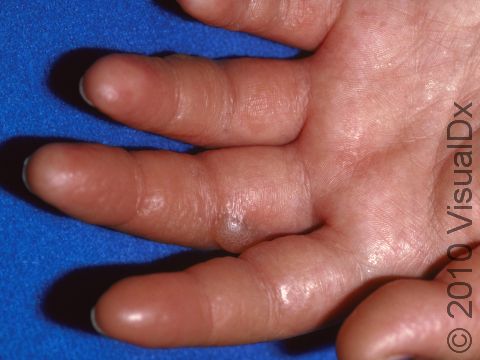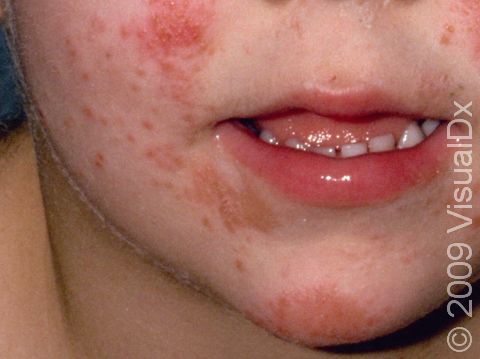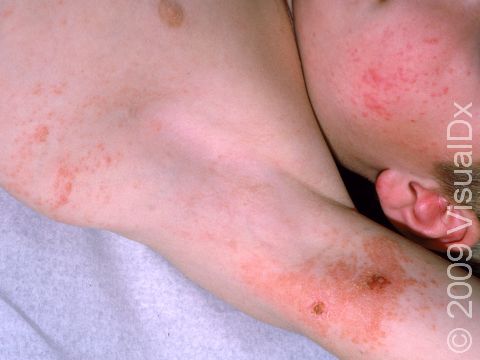Allergic Contact Dermatitis (Pediatric)
Allergic contact dermatitis is a type of eczema (atopic dermatitis) that occurs to a substance (the allergen) touching the skin. Unlike irritant contact dermatitis, which occurs at the time of the allergen touching the skin, allergic contact dermatitis occurs around 24-72 hours after exposure.
The most frequent triggers causing allergic contact dermatitis include:
- Perfumes, nickel, neomycin, formaldehyde, lanolin, oxybenzone, and other chemicals common in the environment.
- Poison ivy, poison oak, and poison sumac.
In infants and toddlers, diapers, powders, creams, and products used in toileting can cause contact dermatitis.
Who's At Risk?
Allergic contact dermatitis can occur at any age, but it is most common in adults. Allergic contact dermatitis can occur in infants, though, and the most common causes in infants differ than those in older children and adults. Because infants are typically protected from the outside environment (eg, the poison ivy plant), the most common causes of allergic contact dermatitis in babies are ingredients in creams and soaps.
Signs & Symptoms
The affected areas of skin can look different on different body areas and on different people. In children, the head, neck, hands, legs, and diaper area are the most common areas of involvement. The diaper area is the area most commonly involved in babies.
There is often redness or other skin color changes in the affected areas, and there may be vesicles or bullae (blisters of different sizes), oozing, and crusting. Or there may be scaly plaques (elevated areas larger than a thumbnail). The lesions may have distinct borders with straight edges and sharp angles. In lighter skin colors, the areas are often pink or red, and in darker skin colors, the redness may be harder to see or may look more purple or gray. Affected areas are typically severely itchy.
When the dermatitis is chronic, the elevated areas can become thickened. Scratching the skin can cause cracks that may become infected with bacteria.
Self-Care Guidelines
- Ideally, you should help your baby avoid whatever is triggering their dermatitis, if known. If you’re not sure what caused the allergic contact dermatitis or if your baby is prone to allergies or has sensitive skin, it may be helpful to avoid common triggers, such as fragrance, lanolin, nickel, etc. The American Contact Dermatitis Society’s Contact Allergen Management Program (CAMP) and SkinSAFE can help you find products that are free of identified allergens.
- Apply cool water compresses to cleanse the area, and then apply over-the-counter 0.5%-1% hydrocortisone ointment twice daily. (Ointments are preferred because they do not sting babies’ skin when applied like creams or lotions can.)
- Avoid using topical antihistamines, such as Benadryl lotion, as these may irritate the skin. Avoid topical antibiotics containing the common allergens bacitracin and neomycin.
- Note that many popular products marketed as hypoallergenic or unscented may contain allergens or irritants.
Treatments
Treatment is aimed at preventing contact with the allergen.
Additionally, your child’s medical professional may prescribe:
- A low-potency topical steroid for use on the thin skin of the face and skinfold areas.
- A medium-potency topical steroid for rash on other parts of the body.
Visit Urgency
See your baby’s medical professional for evaluation if the rash from contact dermatitis does not improve with self-care measures or keeps coming back.
References
Bolognia J, Schaffer JV, Cerroni L. Dermatology. 4th ed. Philadelphia, PA: Elsevier; 2018.
James WD, Elston D, Treat JR, Rosenbach MA. Andrew’s Diseases of the Skin. 13th ed. Philadelphia, PA: Elsevier; 2019.
Kang S, Amagai M, Bruckner AL, et al. Fitzpatrick’s Dermatology. 9th ed. New York, NY: McGraw-Hill Education; 2019.
Paller A, Mancini A. Paller and Mancini: Hurwitz Clinical Pediatric Dermatology. 6th ed. St. Louis, MO: Elsevier; 2022.
Last modified on July 10th, 2025 at 1:40 pm

Not sure what to look for?
Try our new Rash and Skin Condition Finder


